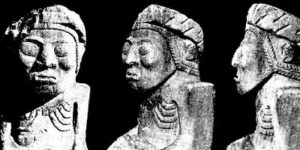The ancient Mayans based their beliefs on the existence of three large planes, balanced related:
- The sky
- The earth
- The underworld.

In these planes, a special type of entity exists. They are called “aluxes”, or “aluxo’ob” in Maya language. Throughout the years, researchers have found its images in many archaeological sites, ancient offerings made to these small beings, represented by clay figures, a few centimeters in height.

According to an old legend, the aluxes are older than the Mayan people, they are the primal men, those who built the big cities. They worked very quickly in the dark, because the sun had not yet appeared, and when this happened, they all turned to stone.
The Alux tradition is so important and so rooted in the local culture, that in 1993, mainstream media reported about a “strange ceremony” in the Mayan ruins of Chichen Itza. In this rite, researchers and workers of the National Institute of Anthropology and History (INAH), asked the Mayan gods for permission to carry out their work, since they wished to protect themselves from the wrath of the aluxes, the pixies in charge of taking care of the lands the crops and the archaeological zones.
The aluxes protect plantations, cornfields and properties. To obtain its favors, a farmer makes a request to the “X´men” (pronounced “SH-men”), or shaman, who uses mud from the land, and a few drops of the land owner´s blood to generate a strong connection between them. The creation process takes seven weeks. Once the process is over, the shaman indicates the name of the master and brings the Alux to life through offerings and prayers, and then places him in a strategic place to become the guardian.

If the“aluxo’ob” master dies, these mischievous pixies go to the service of the god of corn, “Yum K’aax” and if the property they cared for is occupied by a new owner, the aluxes will become mischievous until the new owner, tired of their acts, offeres them food and prayers, until they are accepted.
As in all goblin traditions, these little beings are often naughty and play practical jokes on people crossing their domains. Sometimes they take reprisals that become real nightmares, they are said to produce short screams, strong whirlpools and other phenomena when they get angry and some people consider aluxes “allies of evil” and therefore some farmers think carefully about the convenience of having an alux at their service, since although it will give him/her seven years of good harvests, at the end of that period there is a risk that the goblin will take its master to the Xibalbá (the underworld)

One way or another, aluxes in Yucatan, are deeply linked to the local culture, since they are always present. Either in the Mayan folklore, its legends and its history, or in daily conversations. So be careful if you are out in the Mayan jungle or the fields, since these mischievous beings still roam after sunset, protecting farms, foothills and fields, scaring with whistles and throwing stones to those who trespass and those who commit unlawful acts in the land under their protection.

Aluxes: Does a small race of magical little people live hidden away in remote parts of the Yucatan? (Image: YouTube)
The Yucatan Times
Newsroom

